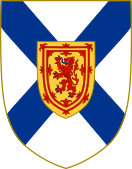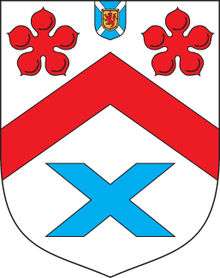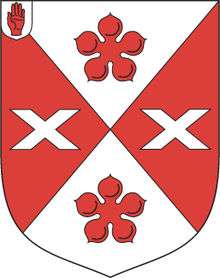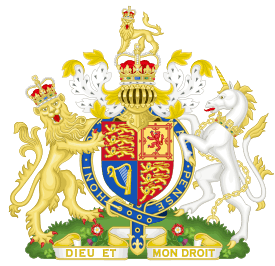Baronet
A baronet (/ˈbærənɪt/ or /ˈbærəˌnɛt/;[1] abbreviated Bart or Bt[1]) or the rare female equivalent, a baronetess (/ˈbærənɪtɪs/,[2] /ˈbærənɪtɛs/,[3] or /ˌbærəˈnɛtɛs/;[4] abbreviation Btss), is the holder of a baronetcy, a hereditary title awarded by the British Crown. The practice of awarding baronetcies was originally introduced in England in the 14th century and was used by James I of England in 1611 as a means of raising funds.

A baronetcy is the only British hereditary honour that is not a peerage, with the exception of the Anglo-Irish Black Knights, White Knights and Green Knights (of whom only the Green Knights are extant). A baronet is addressed as "Sir" (just as is a knight) or "Dame" in the case of a baronetess, but ranks above all knighthoods and damehoods in the order of precedence, except for the Order of the Garter, the Order of the Thistle, and the dormant Order of St Patrick. Baronets are conventionally seen to belong to the lesser nobility, even though William Thoms claims that "The precise quality of this dignity is not yet fully determined, some holding it to be the head of the nobiles minores, while others, again, rank Baronets as the lowest of the nobiles majores, because their honour, like that of the higher nobility, is both hereditary and created by patent."[5]
Comparisons with continental titles and ranks are tenuous due to the British system of primogeniture and because claims to baronetcies must be proven; currently the Official Roll of the Baronetage is overseen by the Ministry of Justice. In practice this means that the UK Peerage and Baronetage consist of about 1,200 families (some peers are also baronets), which is roughly less than 0.01% of UK families.
History of the term
The term baronet has medieval origins. Sir Thomas de La More (1322), describing the Battle of Boroughbridge, mentioned that baronets took part, along with barons and knights.[6] Edward III is known to have created eight baronets in 1328.
Present-day baronets date from 1611 when James I granted letters patent to 200 gentlemen of good birth with an income of at least £1,000 a year; in return for the honour, each was required to pay for the upkeep of thirty soldiers for three years amounting to £1,095, in those days a very large sum. In 1619 James I established the Baronetage of Ireland; Charles I in 1625 created the Baronetages of Scotland and Nova Scotia. The new baronets were each required to pay 2,000 marks or to support six colonial settlers for two years. Over a hundred of these baronetcies, now familiarly known as Scottish baronetcies, survive to this day.
As a result of the Union of England and Scotland in 1707, all future creations were styled baronets of Great Britain. Following the Union of Great Britain and Ireland in 1801, new creations were styled as baronets of the United Kingdom.
Under royal warrants of 1612 and 1613, certain privileges were accorded to baronets. Firstly, no person or persons should have place between baronets and the younger sons of peers. Secondly, the right of knighthood was established for the eldest sons of baronets (this was later revoked by George IV in 1827), and thirdly, baronets were allowed to augment their armorial bearings with the Arms of Ulster on an inescutcheon: "in a field Argent, a Hand Geules (or a bloudy hand)". These privileges were extended to baronets of Ireland, and for baronets of Scotland the privilege of depicting the Arms of Nova Scotia as an augmentation of honour. The former applies to this day for all baronets of Great Britain and of the United Kingdom created subsequently.
The title of baronet was initially conferred upon noblemen who lost the right of individual summons to Parliament, and was used in this sense in a statute of Richard II. A similar title of lower rank was banneret.
Conventions
Like knights, baronets are accorded the style "Sir" before their first name. Baronetesses in their own right use "Dame", also before their first name, while wives of baronets use "Lady" followed by the husband's (marital) surname only, this by longstanding courtesy. Wives of baronets are not baronetesses; only women holding baronetcies in their own right are so styled.
Unlike knighthoods – which apply to the recipient only – a baronetcy is hereditarily entailed. The eldest son of a baronet who is born in wedlock succeeds to a baronetcy upon his father's death, but will not be officially recognised until his name is recognised by being placed on the Official Roll. With some exceptions granted with special remainder by letters patent, baronetcies descend through the male line.
A full list of extant baronets appears in Burke's Peerage and Baronetage, which also published a record of extinct baronetcies.
A baronetcy is not a peerage; so baronets, like knights and junior members of peerage families, are commoners and not peers of the realm (in the UK, all people save the sovereign and peers are considered commoners). According to the Home Office there is a tangible benefit to the honour of baronet: according to law, a baronet is entitled to have "a pall supported by two men, a principal mourner and four others" assisting at his funeral. Originally baronets also had other rights, including the right to have the eldest son knighted on his 21st birthday. However, at the beginning of George IV's reign, these rights were eroded by orders-in-council on the grounds that sovereigns should not necessarily be bound by acts of their predecessors. Although never having been automatically entitled to heraldic supporters, baronets were allowed them in heredity in the first half of the 19th century if the title holder was also a Knight Grand Cross of a Crown order.
Baronets of Scotland or Nova Scotia were allowed to augment their armorial bearings with the Arms of Nova Scotia and the privilege of wearing a neck badge signifying "of Nova Scotia", suspended by an orange-tawny ribbon. This consists of an escutcheon argent with a saltire azure, an inescutcheon of the Royal Arms of Scotland, with an Imperial Crown above the escutcheon, and encircled with the motto Fax Mentis Honestae Gloria. This badge may be shown suspended by the ribbon below the escutcheon.
Baronets of England and Ireland applied to King Charles I for permission to wear a badge. Although a badge was worn in the 17th century, it was not until 1929 that King George V granted permission for all baronets (other than those of Scotland) to wear badges.
Addressing a baronet and the wife of a baronet
A baronet is referred to and addressed as, for example, "Sir Joseph" (using his forename). The correct style on an envelope for a baronet who has no other titles is "Sir Joseph Bloggs, Bt." or "Sir Joseph Bloggs, Bart." The letter would commence: "Dear Sir Joseph".
The wife of a baronet is addressed and referred to as "Lady Bloggs"; at the head of a letter as "Dear Lady Bloggs". Her given name is used only when necessary to distinguish between two holders of the same title. For example, if a baronet has died and the title has passed to his son, the widow (the new baronet's mother) will remain "Lady Bloggs" if he (the son) is unmarried or never marries, but if he is married or becomes married then his wife becomes "Lady Bloggs" while his mother will be known by the style "Alice, Lady Bloggs". Alternatively, the mother may prefer to be known as "The Dowager Lady Bloggs". A previous wife will also become "Alice, Lady Bloggs" to distinguish her from the current wife of the incumbent baronet. She would not be "Lady Alice Bloggs", a style reserved for the daughters of dukes, marquesses and earls.[7]
The children of a baronet are not entitled to the use of any courtesy titles.
Baronetess
In history there have been only four baronetesses:
- Dame Daisy Dunbar, 8th Btss of Hempriggs (1906–97), cr. 1706;[8]
- Dame Mary Bolles, 1st Btss (née Witham) (1579–1662); the only woman apparently to be created a baronetess (of Nova Scotia);[9]
- Dame Eleanor Dalyell, 10th Btss (1895–1972) (cr. 1685), whose title and estate of The Binns passed to her son, the former Labour politician Tam Dalyell MP (who chose not to use the title);
- Dame Anne Maxwell Macdonald, 11th Btss (1906–2011) was recognised by the Lyon Court in 2005 as 11th holder of the baronetcy (formerly Stirling-Maxwell) under the 1707 remainder and succeeded her father in 1956.[10]
In 1976 Lord Lyon King of Arms stated that, without examining the patent of every Scottish baronetcy, he was not in a position to confirm that only these four title creations could pass through female lines.
As of 2020, there are no living baronetesses.[11]
For a baronetess one should write, for example, "Dame Daisy Smith, Btss" on the envelope. At the head of the letter, one would write "Dear Dame Daisy," and to refer to her, one would say "Dame Daisy" or "Dame Daisy Smith" (never "Dame Smith").
Territorial designations
All baronetcies are created with a territorial sub-designation, however only more recent creations duplicating the original creation require territorial designations. So, for example, there are baronetcies Moore of Colchester, Moore of Hancox, Moore of Kyleburn, and Moore of Moore Lodge.
Baronetcies with special remainders
Baronetcies usually descend through heirs male of the body of the grantee, and can rarely be inherited by females or collateral kins, unless created with special remainder, for example:
- with remainder to heirs male forever (Broun baronetcy, of Colstoun (1686), Hay baronetcy of Alderston (1703), etc.)
- with remainder to the sons of the grantee's daughters, and the heirs male of their bodies (Hicking (later North) baronetcy, of Southwell (1920), etc.)
- with remainder to the grantee's daughter's son (Amcotts baronetcy, of Kettlethorp (1796), etc.)
- with remainder to the grantee's son-in-law (Middleton (later Noel) baronetcy, of The Navy (1781), Rich baronetcy, of London (1676), etc.)
- with remainder to the grantee's brother(s) (Chapman baronetcy, of Killua Castle (1782), Pigot baronetcy, of Patshull (1764), White baronetcy of Tuxford and Wallingwells (1802) etc.)
- with remainder, in default of male issue of the grantee, to the grantee's brothers and to the grantee's father's second cousin, and the heirs male of their bodies (Robinson baronetcy, of Rokeby Park (1730))
- with remainder to tailzie succeeding the grantee in the estate (Dalyell baronetcy of The Binns (1685))
- with remainder specifically excluded the grantee's eldest son (Stonhouse baronetcy, of Radley (1628))
Heraldic badges
Red Hand of Ulster
Baronets of England, Ireland, Great Britain or the United Kingdom (i.e. all except baronets of Nova Scotia) can display the Red Hand of Ulster (sinister (left) hand version) as a heraldic badge, being the arms of the ancient kings of Ulster.[12] This badge (or augmentation of honour) is blazoned as follows: Argent a Hand sinister couped at the wrist extended in pale Gules.[13] King James I of England established the hereditary Order of Baronets in England on 22 May 1611, in the words of Collins' Peerage (1741): "for the plantation and protection of the whole Kingdom of Ireland, but more especially for the defence and security of the Province of Ulster, and therefore for their distinction those of this order and their descendants may bear the badge (Red Hand of Ulster) in their coats of arms either in canton or an escutcheon at their election".[14] Since 1929 such baronets may also display the Red Hand of Ulster on its own as a badge, suspended by a ribbon below the shield of arms.[15]
Arms of Nova Scotia
Baronets of Nova Scotia, unlike other baronets, do not use the Baronet's Badge (of Ulster), but have their own badge showing the escutcheon of the arms of Nova Scotia: Argent, a Saltire Azure with an inescutcheon of the Royal Arms of Scotland. From before 1929 to the present it has been customary practice for such baronets to display this badge on its own suspended by the order's ribbon below the shield of arms.[15]
 The Red Hand of Ulster (sinister (left) hand version), as used by baronets (other than those of Nova Scotia) as a heraldic badge
The Red Hand of Ulster (sinister (left) hand version), as used by baronets (other than those of Nova Scotia) as a heraldic badge Arms of Nova Scotia: Argent, a Saltire Azure an inescutcheon of the Royal Arms of Scotland, as used by baronets of Nova Scotia as a heraldic badge
Arms of Nova Scotia: Argent, a Saltire Azure an inescutcheon of the Royal Arms of Scotland, as used by baronets of Nova Scotia as a heraldic badge Coat of arms of the Agnew baronets (1629) with the badge of a Baronet of Nova Scotia (Coat of arms of Nova Scotia) in chief
Coat of arms of the Agnew baronets (1629) with the badge of a Baronet of Nova Scotia (Coat of arms of Nova Scotia) in chief Coat of arms of the Agnew baronets (1895) with the badge of a Baronet of the United Kingdom (Red Hand of Ulster) in canton
Coat of arms of the Agnew baronets (1895) with the badge of a Baronet of the United Kingdom (Red Hand of Ulster) in canton A baronet's medal ribbon
A baronet's medal ribbon
Number of baronetcies
| Creations | Total | Baronets | Peers |
|---|---|---|---|
| Baronets of England | 133 | 82 | 51 |
| Baronets of Ireland | 57 | 34 | 23 |
| Baronets of Nova Scotia | 103 | 73 | 30 |
| Baronets of Great Britain | 122 | 91 | 31 |
| Baronets of the United Kingdom | 789 | 682 | 107 |
| Total | 1204 | 962 | 242 |
The first publication listing all baronetcies ever created was C. J. Parry's Index of Baronetcy Creations (1967). This listed them in alphabetical order, other than the last five creations (Dodds of West Chillington, Redmayne of Rushcliffe, Pearson of Gressingham, Finlay of Epping and Thatcher of Scotney). It showed the total number created from 1611 to 1964 to have been 3,482. They include five of Oliver Cromwell, several of which were recreated by Charles II. Twenty-five were created between 1688 and 1784 by James II in exile after his dethronement, by his son James Stuart ("The Old Pretender") and his grandson Charles Edward Stuart ("Bonny Prince Charlie"). These "Jacobite baronetcies" were never accepted by the English Crown, have all disappeared and should properly be excluded from the 3,482, making the effective number of creations 3,457. A close examination of Parry's publication shows he missed one or two,[17] so there might well have been some more.
As of 2000, including baronetcies where succession was dormant or unproven, there was a total of 1,314 baronetcies divided into five classes of creation included on The Official Roll of the Baronetage – 146 of England, 63 of Ireland, 119 of Scotland, 133 of Great Britain and 853 of the United Kingdom.
The total number of baronetcies today is approximately 1,204, although only some 1,020 are on The Official Roll of the Baronetage.[17] It is unknown whether some baronetcies remain extant and it may be that nobody can prove himself to be the actual heir. Over 200 baronetcies are now held by peers; and others, such as the Knox line, have been made tenuous by internal family disputes.
Baronetage decline since 1965
There were 1,490 baronetcies extant on 1 January 1965. Since then the number has reduced by 286 through extinction or dormancy: a gross decline of 19.2% (up to 2017). Extant baronetcies numbered about 1,236 in 2015,[18] and 1,204 as of 2017.
Since 1965 only one new baronetcy has been created, for Sir Denis Thatcher on 7 December 1990, husband of a former British prime minister, Margaret Thatcher (later Baroness Thatcher); their eldest son, Sir Mark Thatcher, succeeded as 2nd Baronet upon his father's death in 2003.[19]
Seven baronetcies dormant in 1965 have since been revived: Innes baronetcy, of Coxton (1686), Nicolson baronetcy of that Ilk and of Lasswade (1629), Hope baronetcy, of Kirkliston (1698), St John (later St John-Mildmay) baronetcy, of Farley (1772), Maxwell-Macdonald baronetcy of Pollok (1682)[18], Inglis baronetcy, of Cramond, Edinburgh (1687) and Von Friesendorff baronetcy, of Hirdech, Sweden (1661).
Premier Baronet
England
The Premier Baronet (of England) is the unofficial title afforded to the current holder of the oldest extant baronetcy in the realm. The Premier Baronet is regarded as the senior member of the Baronetage, and ranks above other baronets (unless they hold a peerage title) in the United Kingdom Order of Precedence. Sir Nicholas Bacon, 14th Baronet, is the current Premier Baronet; his family's senior title was created by King James I in 1611.
Scotland
The Premier Baronets of Nova Scotia (Scotland) were the Gordon baronets of Gordonstoun and Letterfourie until the title's extinction in 1908.[20] Subsequently, the Premier Scottish Baronets are the Innes baronets of that Ilk (cr. 28 May 1625),[21] the present Premier Baronet being Charles Innes-Ker, 11th Duke of Roxburghe.
Ireland
The Premier Baronetcy of Ireland was created for Sir Dominic Sarsfield in 1619, and was held by his successors until the attainder of the 4th Viscount Sarsfield in 1691.[22] Since then the descendants of Sir Francis Annesley Bt., the Annesley baronets, have been the Premier Baronets of Ireland;[23] presently Francis William Dighton Annesley, 16th Viscount Valentia.
Baronetcies conferred upon British expatriates and non-British nationals
In fiction
See also
- Standing Council of the Baronetage
- List of extant baronetcies
- List of baronetcies (currently incomplete)
- British Honours System
- Canadian peers and baronets
References and sources
- References
- "Baronet". Collins Dictionary. n.d. Retrieved 23 September 2014.
- "Baronetess". Dictionary.com Unabridged. n.d. Retrieved 15 August 2016.
- "baronetess". Oxford English Dictionary (3rd ed.). Oxford University Press. September 2005. (Subscription or UK public library membership required.)
- "Baronetess". Collins Dictionary. n.d. Retrieved 23 September 2014.
- William J. Thoms (1844). The Book of the Court (2nd edition). London: Henry G. Bohn, York Street, Covent Garden, p. 132
- Stubbs, Vol. II, Part IV, p 303
- Debrett's Correct Form. Addressing the family of a Baronet. Archived 15 August 2011 at the Wayback Machine
- Leigh Rayment's baronetage: Draper to Dymoke
- Cokayne's Complete Baronetage
- (See page B 599 of the Baronetage section of the latest edition of Debrett.)
- "Official Roll of the Baronetage (as at 3 March 2020)» The Standing Council of the Baronetage -".
- Collins, 1741, p.287
- Collins, Arthur, The English Baronetage: Containing a Genealogical and Historical Account of all the English Baronets now Existing, Volume 4, London, 1741, p.287
- Collins, 1741, vol.4, p.287
- Debrett's Peerage, 1968, p.1235
- Kershaw, Stephen. "BARONETS OF ENGLAND, SCOTLAND, IRELAND, GREAT BRITAIN AND THE UNITED KINGDOM" (PDF). The Standing Council of the Baronetage. Archived from the original (PDF) on 7 November 2017. Retrieved 21 September 2017.
- Sir Martin Lindsay of Dowhill, Bt (1979). The Baronetage, 2nd edition.
- "Baronetage decline since 1965". Retrieved 21 September 2015.
- "The Baronetage". Debretts. Archived from the original on 25 February 2013. Retrieved 13 April 2013.
The creation of baronetcies lapsed in 1964; in 1990 the Conservative Government announced that this honour would be given to Denis Thatcher, but there have been no further creations
- Cokayne, vol ii, pp277-280
- Cokayne, vol ii, p 280
- Cokayne, vol i, pp223-224
- Cokayne, vol ii, p 224
- Sources
- Sir Martin Lindsay of Dowhill, Bt (1979). The Baronetage, 2nd edition. (published by the author).
- William Stubbs (1883). Chronicles of the Reigns of Edward I and Edward II, Vol. 2, Part IV - Vita Et Mors Edwardi II Conscripta A Thoma de La More. Longman & Co.
- Debrett's website
- Burke's website
External links
| Wikisource has the text of the 1911 Encyclopædia Britannica article Baronet. |
.svg.png)
